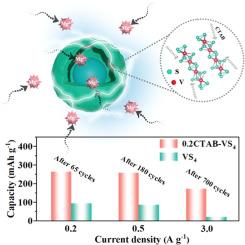ctab诱导的带有硫空位的VS4蛋黄壳微球增强了镁的储存
IF 14.3
1区 材料科学
Q1 MATERIALS SCIENCE, MULTIDISCIPLINARY
引用次数: 0
摘要
针对可充电镁电池(RMBs)容量快速衰减和循环寿命有限的问题,提出了一种将阳离子表面活性剂与金属化合物相结合的策略。通过原位引入阳离子表面活性剂十六烷基三甲基溴化铵(CTAB),成功合成了一种富含硫空位的壳壳结构CTAB- vs4复合材料。CTAB改性达到了“一石三鸟”的多功能效果:(1)扩大了层间间距,诱导了丰富的硫空位,增加了Mg2+的扩散速率和镁的储存位点;(2)构建了具有高比表面积的蛋黄壳结构,为Mg2+提供了充足的活性位点。(3)降低界面阻抗,优化电子结构,稳定Mg阳极。因此,CTAB-VS4阴极在RMBs中表现出优异的电化学性能,在0.5和3 A g - 1下,循环180次和700次后分别提供258和173 mAh g - 1的高放电比容量。系统表征证实了可逆的Mg2+插入机理。这种通过阳离子表面活性剂的协同调节为制备高性能RMBs提供了一条很有前途的途径。本文章由计算机程序翻译,如有差异,请以英文原文为准。

CTAB-induced VS4 yolk-shelled microspheres with sulfur vacancies for enhanced magnesium storage
To address the challenges of rapid capacity decay and limited cycle life in rechargeable magnesium batteries (RMBs), which are primarily caused by slow Mg2+ diffusion kinetics and structural collapse of the cathode material, we propose a strategy integrating cationic surfactant with metal compounds. A sulfur vacancy-rich CTAB-VS4 composite with yolk-shell structure is successfully synthesized by in-situ introduction of cationic surfactant cetyltrimethylammonium bromide (CTAB). The CTAB modification achieves a multifunctional “one stone, three birds” effect: (1) Expanding the interlayer spacing and inducing rich sulfur vacancies, the diffusion rate of Mg2+ and the magnesium storage sites are increased. (2) Constructing a yolk-shell structure with a high specific surface area, providing ample active sites for accommodating Mg2+. (3) Reducing the interface impedance, optimizing the electronic structure, and stabilizing the Mg anode. Consequently, the CTAB-VS4 cathode exhibits exceptional electrochemical performances in RMBs, delivering high discharge specific capacities of 258 and 173 mAh g−1 at 0.5 and 3 A g−1 after 180 and 700 cycles, respectively. Systematic characterizations confirm the reversible Mg2+ intercalation mechanism. This synergistic modulation through cationic surfactant provides a promising pathway toward high-performance RMBs.
求助全文
通过发布文献求助,成功后即可免费获取论文全文。
去求助
来源期刊

Journal of Materials Science & Technology
工程技术-材料科学:综合
CiteScore
20.00
自引率
11.00%
发文量
995
审稿时长
13 days
期刊介绍:
Journal of Materials Science & Technology strives to promote global collaboration in the field of materials science and technology. It primarily publishes original research papers, invited review articles, letters, research notes, and summaries of scientific achievements. The journal covers a wide range of materials science and technology topics, including metallic materials, inorganic nonmetallic materials, and composite materials.
 求助内容:
求助内容: 应助结果提醒方式:
应助结果提醒方式:


